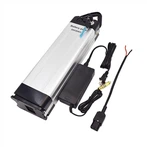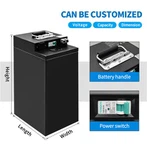Electric bikes are gradually changing people's lives. As more people purchase electric bikes, there is growing attention to their performance and the components used, especially the various parameters of the e-bike battery. Are you able to understand all these specifications? As a leading electric bike battery manufacturer, today we'll use this article to help you understand what does 48v 20ah mean on an e-bike battery?

Understanding E-bike Battery Specifications
Before diving into the details of "48v" and "20ah," it's important to first understand the key battery specifications that define the performance of an e-bike. These include voltage, capacity, and amp hour rating-each of which plays a pivotal role in determining your bike's capabilities.
Voltage (V): Voltage is the force that drives the electrical current through the battery. In the case of e-bike batteries, higher voltage means more power, allowing the motor to work harder, thus supporting faster speeds and more demanding rides. A 48v battery, for example, provides a higher output than lower voltage options, such as a 36v battery or a 48v 10ah configuration.
Capacity (Ah or amp-hours): Battery capacity, measured in amp hours (Ah), indicates how much energy the battery can store. The higher the capacity, the longer your e-bike can run on a single charge before needing to be recharged. A 20ah battery offers higher capacity compared to a 10ah battery, which means longer range and better performance for long-distance cycling.
These two key specs, voltage and capacity, together determine the overall efficiency and performance of your e-bike's power system.
What Does "48v" Mean on an E-bike Battery?
Let's first look at the 48v specification. 48v refers to the voltage of the battery. This value is a critical factor in determining the power output of your e-bike's motor. Here's how it works:
Power and Speed: A 48v battery delivers more power to the motor than a 36v or 24v battery, which translates into faster speeds and better acceleration. With a higher voltage, the motor can produce more torque, which is especially beneficial for riders who tackle hills or rough terrains. This makes 48v electric bike batteries ideal for long rides, faster commutes, or off-road cycling.
Higher Voltage and Performance: With 48v systems, riders can expect smoother, more consistent power delivery, especially when using a larger battery pack or a high-performance motor. The 48v 20ah battery setup, for example, provides a combination of higher voltage and larger capacity, giving riders the ability to power through various challenges without worrying about running out of battery too quickly.
Compatibility with Powerful Motors: 48v batteries are compatible with more powerful motor types, including hub motors and mid-drive motors. These motor systems can draw higher currents, and a 48v 20ah battery can provide enough energy to meet the demands of these systems. As a result, you get improved performance across various speed ranges, even on steeper inclines.
What Does "20ah" Mean on an E-bike Battery?
Now let's focus on the second part of the equation-20ah. This refers to the capacity of the battery, measured in amp-hours (Ah). Capacity is essentially a measure of how much energy the battery can store, and a higher capacity battery allows you to ride longer distances before needing a recharge. Here's how 20ah compares to other battery sizes:
- Battery Capacity: A 20ah battery can deliver 20 amps of current for one hour, or 1 amp for 20 hours, making it a good option for riders who want a battery that lasts longer. When compared to a 10ah battery, the 48v 20ah battery offers a significant increase in capacity, which directly translates to extended range and more power.
- Range and Longevity: With a 20ah battery, you can expect to travel much farther on a single charge than with a 10ah battery. Depending on your riding style, terrain, and motor efficiency, a 48v 20ah battery can allow you to cover up to 60-80 miles per charge. On the other hand, a 48v 10ah battery will likely offer a range of around 30-40 miles.
- Higher Capacity Equals Better Performance: If you need a battery for longer commutes, mountain biking, or extended tours, the higher capacity of a 20ah battery will ensure that you have the power needed to maintain a consistent speed without depleting your energy too quickly. As Battery University notes, higher capacity batteries are preferred for more demanding applications, as they deliver sustained power without significant drops in performance.

How Do Voltage and Capacity Affect E-bike Performance?
When it comes to choosing the right e-bike battery, both voltage and capacity play a crucial role. Here's how the combination of a 48v 20ah battery impacts your bike's performance:
Increased Range: With the higher voltage of a 48v system, your motor can provide better power, while the 20ah capacity ensures you have enough energy to go further. This combination is ideal for riders who want a battery that supports long-range cycling. Compared to a 48v 10ah system, a 48v 20ah battery will provide nearly double the range on a single charge, making it ideal for daily commuting or long-distance rides.
Smoother, More Consistent Power: 48v systems generally offer smoother acceleration and more consistent power throughout the ride. The larger battery also means that the motor doesn't have to work as hard to maintain performance, reducing wear and tear on both the motor and battery cells.
Higher Power for Tougher Terrains: With a 48v 20ah battery, riders can enjoy greater motor efficiency, especially on hilly or rough terrain. The higher voltage helps the motor maintain high output even on steep inclines or when carrying heavy loads.

Why Choose a 48v 20ah E-bike Battery?
If you're in the market for a new e-bike or considering an upgrade, a 48v 20ah battery provides several benefits over other configurations. Here's why you might choose this option:
Longer Commutes: With the higher capacity of a 20ah battery, you can travel much farther without needing to recharge. Whether you're commuting long distances or exploring new areas, this configuration gives you the power to go further on a single charge.
Better Performance for Hilly Terrain: If you often ride in hilly areas, the 48v 20ah battery provides more power to help you climb steep inclines without losing speed or efficiency. The additional amp hours (Ah) also ensure that your motor has enough energy to maintain performance over challenging routes.
Future-Proofing Your E-bike: As the e-bike market continues to evolve, 48v electric bike batteries are becoming the industry standard for mid-range to high-end bikes. By investing in a larger battery with higher capacity, you ensure your e-bike remains capable of handling future upgrades and technologies.
Alternatives to the 48v 20ah Battery
While the 48v 20ah battery is an excellent choice for many riders, it's important to consider your specific needs. If you don't need as much range or power, there are alternatives worth exploring:
36v Batteries: Common in entry-level e-bikes, 36v batteries are lighter and more affordable but provide less power. They're suitable for short commutes or riders who don't require a lot of extra boost.
52v Batteries: For those seeking even more power, a 52v battery may be a better choice. Higher voltage allows the motor to perform at a higher wattage, resulting in faster speeds and greater torque. However, this configuration also increases the weight and cost of the bike.
Tips for Maximizing the Lifespan of Your 48v 20ah Battery
To get the most out of your 48v 20ah battery, here are a few maintenance tips:
Avoid Overcharging: Always avoid overcharging your battery. Keeping the charge level between 20% and 80% is ideal for extending the life of your battery pack.
Store Properly: Store your battery in a cool, dry place to prevent degradation of the battery cells. Extreme temperatures can damage the battery and shorten its lifespan.
Use Regularly: Batteries that are used regularly tend to last longer than those that sit idle. Regular use helps maintain the capacity (Ah) and keeps the cells in good condition.









